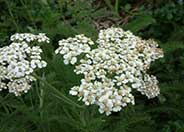
Common name:Yarrow
Botanical name:Achillea millefolium
This Achillea features spreading mats of fern-like rosettes, along with deeply divided leaves of a green or gray green color. In this form, the flowers are usually a white tone. Stems can reach 2'-3' above foliage. Yarrows propagate easily from rooted cuttings or division, which should be performed in the early spring or fall. Following bloom, one should dead head the plant and divide the clumps when it appears crowded.
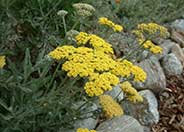
Common name:Yarrow Moonshine
Botanical name:Achillea 'Moonshine'
Pale yellow flowers appear to float on long, slender stems. Leaves are green to gray-green leaves, which are flatter and less divided than those of the Achillea millefolium. Yarrows propagate easily from rooted cuttings or division, which should be perfo Yarrows propagate easily from rooted cuttings or division, which should be performed in the early spring or fall. Following bloom, one should dead head the plant and divide the clumps when it appears crowded.
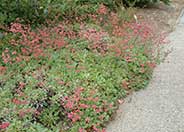
Common name:Red Buckwheat
Botanical name:Eriogonum grande rubescens
Red Buckwheat is a low growing, woody perennial 1'-2' high and 3' wide. It has showy, dark pink summer flowers that stand out against small, gray green foliage. It is a CA native that is drought tolerant. It attracts butterflies and benefical insects.
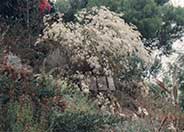
Common name:St. Catherine's Lace
Botanical name:Eriogonum giganteum
St. Catherine's Lace is a large open shrub growing 4'-5' high and 3'-4' wide with woolly, gray leaves and flat clusters of cream flowers that turn rust with age. It is a CA native that is drought tolerant. It attracts butterflies and beneficial insects.
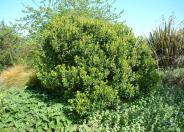
Common name:California Coffeeberry
Botanical name:Frangula californica
The California coffeeberry is an evergreen shrub that reaches 6'-8' high. It grows inland and has large green to black berries in late summer. This shrub tolerates sun or partial shade in all soil types. The California coffeeberry is a native to California and is drought tolerant. It is a beneficial insect plant and attracts butterflies.
Designer:
Photographer: GardenSoft
Physical weed control, including mulching, or hand removal protects the watershed from harmful chemicals.
Adjust sprinklers to avoid watering sidewalks and driveways.
Develop healthy soil for plants that are vigorous and naturally pest-resistant.